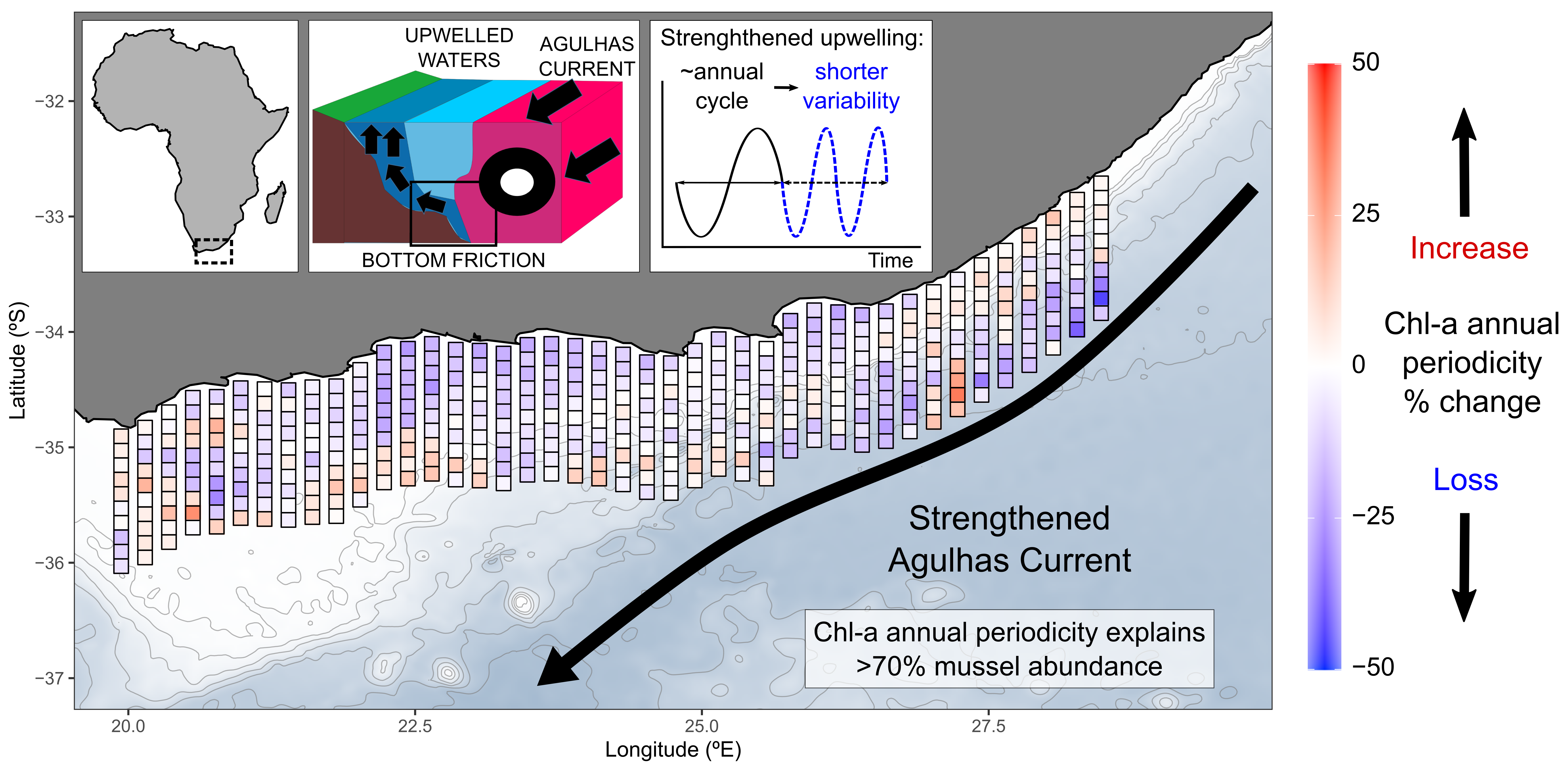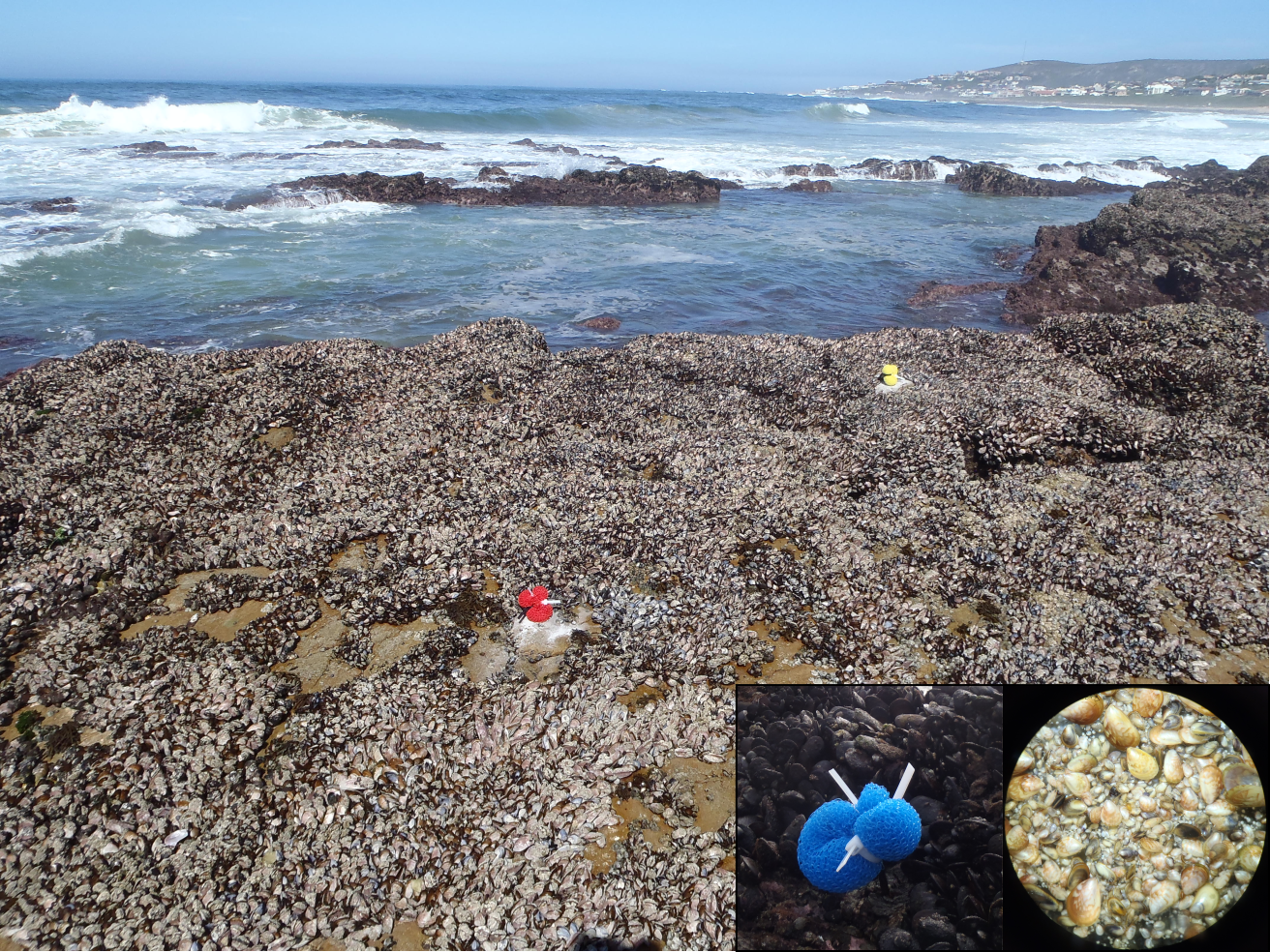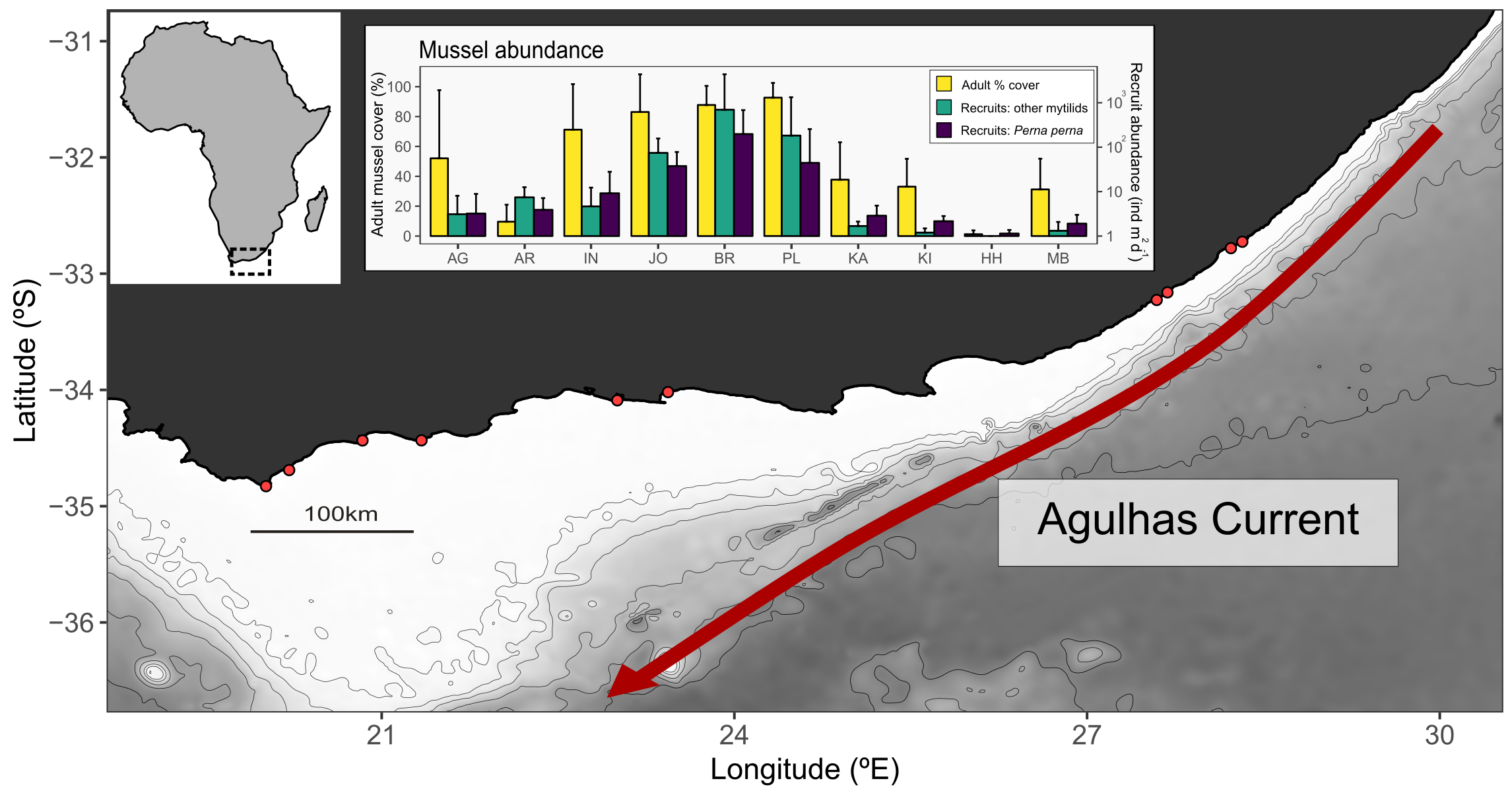New publication: seasonality and coastal organisms
I have recently co-authored a paper entitled Seasonality of primary productivity affects coastal species more than its magnitude, with Prof. Christopher D. McQuaid and Dr. Nicolas Weidberg. The paper was published in Science of the Total Environment and can be accessed here.
 Graphical abstract from the original publication. The map shows the increase (reddish values) or decrease (blueish) in chlorophyll periodicity (chl-a, a proxy of food availability in the water). A strengthening of the Agulhas Current may be the indirect mechanism behind those changes.
Graphical abstract from the original publication. The map shows the increase (reddish values) or decrease (blueish) in chlorophyll periodicity (chl-a, a proxy of food availability in the water). A strengthening of the Agulhas Current may be the indirect mechanism behind those changes.
In this paper, we seek to understand the relationship between variability of environmental conditions and the general pattern of distribution of coastal organisms, using the south coast of South Africa and the distribution of mussels as a study case.
So, what about the coast of South Africa?
South Africa is placed in the intersection of two oceans - the Indian Ocean to the east and the Atlantic Ocean the west. Because of that, the country in under the influence of two major currents which are very different and which will influence the coastal area in different ways: the southeast coast is bathed by the warm Agulhas Current which flows parallel to the coast towards the southwest, while the west coast is influenced by the cold Benguela Current.
Productivity in the coastal area is boosted when deep, cold, nutrient-rich waters are upwelled to the surface. On the west coast, the intensity and persistence of that upwelling is higher than in the southeast, but the influence of winds and the Agulhas Current flow can also produce this phenomenon in certain areas of the southeast coast, especially during the summer and autumn months.
Accordingly, both currents create a marked spatial pattern in abundances of organisms and number of species occurring along the coast, with the west coast being more productive and having higher abundances of organisms, and the southeast coast having lower abundances, but higher species’ diversity.
The three coasts of South Africa, marked by the changes in abundance and diversity. Poster found in Cape Agulhas, at the southernmost tip of Africa.
A closer look at the south coast of the country reveals high abundances of mussels in the rocky shores, creating dense mussel beds which appear as a carpet covering the rock. In that regard, mussels play an important role, because those beds not only provide physical protection for smaller organisms, but they also modify temperature and humidity conditions. Thus, the presence of mussels makes the environment less harsh for other small organisms, offering refuge when the tide is low and the area is exposed to the air and the sun.
 Mussel bed in Jongensfontein, South Africa. Two plastic collectors can be seen in the picture, used for estimating mussel recruitment. Adult mussels are seen occupying most of the space available in the photograph. The area is uncovered during several hours when the tide is low, but it will be submerged again during high tide. On the bottom right a close-up of a collector (left), and the mussel recruits collected as seen under a dissecting scope (right).
Mussel bed in Jongensfontein, South Africa. Two plastic collectors can be seen in the picture, used for estimating mussel recruitment. Adult mussels are seen occupying most of the space available in the photograph. The area is uncovered during several hours when the tide is low, but it will be submerged again during high tide. On the bottom right a close-up of a collector (left), and the mussel recruits collected as seen under a dissecting scope (right).
Why this study?
Many coastal organisms, like mussels, reproduce by releasing eggs and sperm into the water. The fertilised eggs will develop into larvae, which will grow and develop in the adjacent water mass until they are ready to settle back in suitable areas of the coast. This means that the adults will require some kind of cue to trigger the release of eggs and sperm simultaneously to the water, increasing the chances of fertilisation being successful. Some of those cues are related to food availability and other environmental conditions which are favourable for the adults to mature sexually, but also for the larvae to survive on their own. For instance, larvae are known to feed on phytoplankton (microscopic algae that grow in the water), making food availability in the water a very important aspect for their survival, and requiring the timing of food availability in the water and presence of larvae to be right.
When trying to understand the patterns of abundance or distribution of species, ecological studies usually focus on the average conditions in the system. In fact, within a spatial range of environmental conditions that a species can tolerate, it is proposed that its abundance will be highest at the centre of that range (where the conditions impose the lowest stress), while abundance will decrease as stress increases. Nevertheless, conditions may be patchy within that range, or vary in time, creating hotspots where conditions could be more favourable.
Thus, predictability of environmental conditions can be extremely relevant for survival and replenishment of new organisms to the coastal areas. Understanding how temporal and spatial variability relate to organisms’ distribution or abundance is key, specially considering that global changes in climate will likely affect the way that conditions vary in time, or the mechanisms driving those conditions.
Mussel abundances peak in the central part of the south coast of South Africa, decreasing towards the sides. This spatial pattern makes it an excellent model area to study the relationship between environmental conditions and abundance of this ecologically important species.
 Abundances of adult mussels (yellow bars), and recruits (two groups of mussels, in green and purple), along the south coast of South Africa. Samples correspond to 10 sites from west to east (represented by red dots on the map).
Abundances of adult mussels (yellow bars), and recruits (two groups of mussels, in green and purple), along the south coast of South Africa. Samples correspond to 10 sites from west to east (represented by red dots on the map).
In this case, 15 years of satellite data were examined to study how coastal conditions varied in time (i.e. their frequency). We focused on assessing the variability of food and water temperature, as well as their relationship with the distribution of mussels along the south coast of the country. For this, we used the abundances of adults and recruits (very young mussels which may be several weeks old, see bottom-right photograph of mussel bed).
The main highlights that we found were:
-
The spatial distribution of mussels was more strongly related to how food availability fluctuates in time than food availability itself (i.e. seasonality of food was more important than the average amount of food available during the year)
-
During the past years, there has been a decrease in predictability of environmental conditions around ecologically important areas
-
And, a significant cooling has occurred around those areas, most likely related to changes in the behaviour of the Agulhas Current, which is the main water current dominating the area and which influences coastal dynamics
These results show a strong relationship between organisms’ abundance and predictability of the conditions experienced, in particular food seasonality. It is highly relevant to account for this information in future modelling efforts for coastal populations, especially considering the possible effects that such changes may have on the early life cycle of organisms.
If you want to know more, you can read the full paper here.